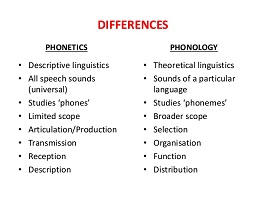Contrastive distribution with examples definition Phonology morphology syntax
Contrastive distribution
Contrast distribution in linguistics, as opposed to complementary distribution or free variation, is a relationship between two different elements in which both elements are in the same environment with a change in meaning. we will describe here the concept of Contrastive distribution with examples
Two sounds meet in the same environment and differentiate between words. In this case, they are representatives of different phonemes.
For example, from a series of words “volume, house, lump, scrap, rum, catfish” it is clear that in Russian. lang. there are phonemes / t /, / d /, / k /, / l /, / m /, / s /, since in the same environment [ ohm ] they allow to distinguish different words.
In Phonology
In phonology, it is said that two sounds of a language are in a contrasting distribution if the replacement of one for another in the same phonological environment results in a change in meaning. If a sound has a contrasting distribution, it is considered a phoneme in that language.
For example, in English, the sounds [p] and [b] can appear at the beginning of a word, as in pat and bat ( minimal pairs ), which are different morphemes. Hence, [p] and [b] are in contrasting distribution, as are the phonemes of the English language. Note that two sounds that are in contrasting distribution in one language may be in an additional distribution or in free variation in another. These sounds are found in English, for example, in the words team [tʰiːm] and steam [stiːm], but their appearance depends entirely on the phonological context. Hence, in English, [tʰ] and [t] are not in contrasting distribution, but in complementary distribution.
In Morphology
In morphology, two morphemes are in contrasting distribution if they occur in the same environment, but have different meanings.
For example, in Korean , phrases with nouns are followed by one of the various markers indicating the syntactic role: / -ka /, / -i /, / – (l) ul /, etc. / -Ka / and / -i / are in complementary distribution. Both are used to indicate the nominative case , and their appearance is due to the last sound of the previous noun. If a noun ends in a consonant, / -i / is encountered; otherwise / -ka /. / – (l) ul /, on the other hand, occurs in the same position as / -i / or / -ka /, and is also due to the immediately preceding sound, but indicates the accusative case . Therefore, / – (l) ul / and the set {/ -i /, / -ka /} are comparatively distributed.
In Syntax
In terms of syntax, the requirements are similar. In English, the expression of the indicative and subjunctive moods is contrasted:
If I am a rich person, then I have a lot of money.
If I were a rich person, I would have a lot of money.
The transition from the non-past first person singular, indicating morning to the subjunctive, was the result of changing the mood of the sentence.
we have described here the concept of Contrastive distribution with examples. Hope you understood it completely.


